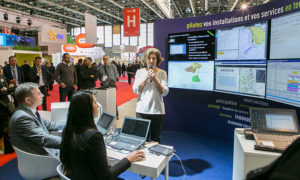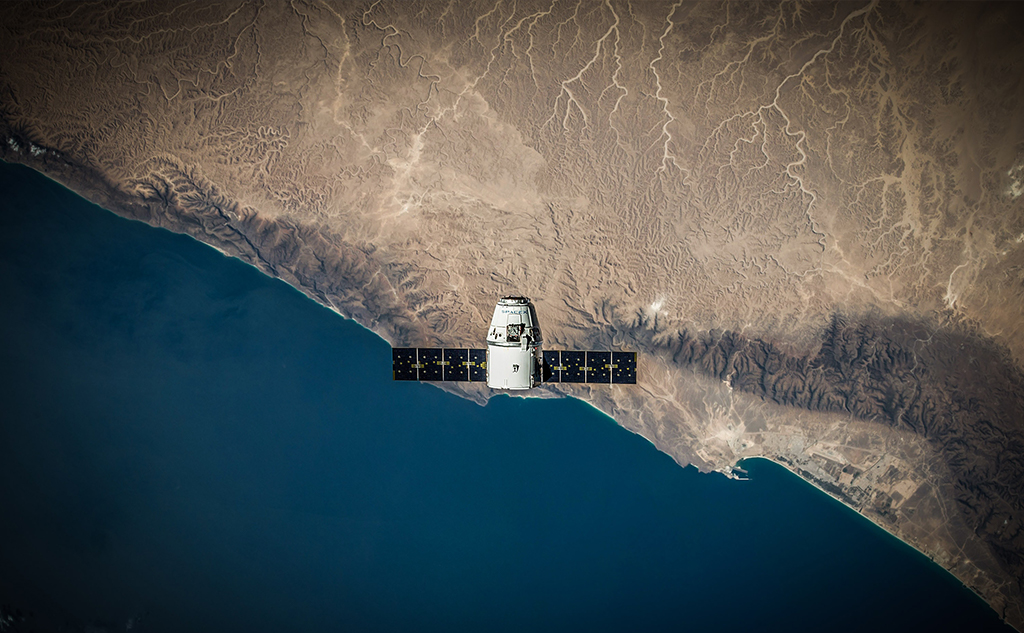How digital technology and connected devices are having an impact on environmental issues
According to the Grand View Research consulting company, smart city markets have recorded annual growth of 13% since 2014. This figure reflects how significant this area has become in respect to environmental issues in recent years.
At Pollutec, information technology and telecommunications have been employed for a long time, not just for metrology, but also in decision making as well as manufacturing operations and modelling. Yet a new digital “transition” has been occurring since 2011 with environmental technologies including systematic references to device connection capabilities, data management, or even robotics and drones. This can also be seen in every sector: energy, water, air, waste, soil, risks, sustainable cities. What is there to be gained? Provide information in real time. Get a more detailed idea of particular goings-on. Rank priorities, set up early warnings to reduce risks, identify drifts for preventative maintenance. Or quite simply, optimise operations and increase productivity.
The latest resource: satellite and radar data
With satellites and radars, a huge data resource now exists for new environmental applications. This is what prompted the idea of a Space Village in 2011 to present these promising opportunities. 5 years later, the start-up Weather Measures presented a solution in the Village that could gather precise rainfall information using algorithms that exploited and combined multiple sources of complex data from satellites and weather radars.
Worldwide services for sustainable cities
Numerous service offers are now centred on connected sensors (on low-energy and long-distance protocols) and tools for processing and interpreting platform data. This is especially the case in urban applications such as automatic meter reading, network monitoring, air quality and monitoring lighting. For the benefit of a necessary, cross-cutting approach, the theme of sustainable cities embraces the role of these different tools used by businesses like BIRDZ (formerly M2Ocity), GreencityZen, Ingenious, Sophice and Ecomesure.

The strength of algorithms in the air
For more than 15 years, the exhibition has shown modelling solutions for air pollution dispersion (e.g. Aria Technologies, Numtech, Fluidyn). Today, they are enriched by data from connected sensors. Yet the potential of digital technology is also reflected in “lighter” tools like Geco Air / IFPen. This eco-driving application checks on various settings to reduce the impact of car journeys on the air.
Simplified energy data collection
The energy sector is one of the most prolific in terms of digital and connected devices. An example of this was seen in 2016 with Gulplug and its small stand-alone, connected sensor. It clips on to an electric cable to monitor the connected device’s consumption in real time. Smart Impulse was just as striking. It received an award in 2012 for its meter that could “listen” to the electric signal and distinguish between different types of consumption without increasing the number of sensors.
Information about waste obtained from everyday data
A great example of data science’s potential is PrediWaste, designed in 2012 by Datapole. The application helps waste managers forecast their operations (in terms of volume and location) through sophisticated cross-referencing of external data. This includes weather reports, the academic year, business activity and other factors that could influence the production of waste.
2018: THE YEAR OF DIGITAL TECHNOLOGIES FOR CLIMATE AND THE ENVIRONMENT
Artificial intelligence, data processing, ITC, blockchain, cyber-security, collaborative tools, virtual or augmented reality, etc. The whole range of digital technologies is increasingly present in solutions dedicated to the environment or climate.
As well as the energy efficiency sector, all green growth sectors are concerned. Digital technology plays an integral role in the water sector, notably in the management of networks and instrumentation. It is also increasingly present in the air sector both in metrology devices and in the treatment systems. Finally, it is omnipresent in the waste sector (collection, recycling, sorting), in site and soil management and in risk prevention. The two interdisciplinary focus events at Pollutec – sustainable cities and sustainable industry – are also affected, with intelligence and connected integrated at all levels (e.g.: urban mobility, process efficiency, etc.).
INNOVATIONS 2018 INTEGRATING DIGITAL TECHNOLOGY
Of the 156 innovations validated on 2 November 2018 (on-line at www.pollutec.com), over 60 employ digital technologies.
Water resource management: AquaSys, Ax’Eau, Boschung, Chemdoc, Hydroscan, Maddalena, Protecto, Siemens, Suez, Weg France, Xylem Water Solutions
Network management and process efficiency: BioEntech, Birdz, EMZ Environnement, Suez, Lacroix Sofrel, Norham, Weg France, Xylem Water Solutions
Collection – Cleaning – Pressure washing: Eurovoirie
Waste treatment – Recycling: AZ Métal, Packmat System, Pausecom, Pellenc ST, Suez, Tomra, Vauché
Recycling – Reuse – Matter and Materials: HSE Optimisation
Energy: Startec Développement, S’Tile
Energy efficiency: Chemdoc, Clauger, Enviro Développement, Kaeser Compresseurs, Siemens, Weg France
IMA: BioEntech, Bürkert, CT2MC, Gutermann, Icohup, Ijinus, Kamstrup, Nogema, PR Electronics, Suez, Sysoco, Utilities Performance, Watura, Weg France, Xylem Analytics
Air – Odours – Noise: Ecomesure, Envea, Ethera, IS Cleanair
Risks: Blackline Safety, Kiloutou, TechnoBAM/Qista
Sites & Soils: Envisol
Urban development, mobility, lighting: Addax Motors, GTI European, SupraWays




